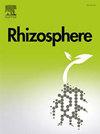Nitrogen addition and rhizosphere effects differentially shape prokaryotic and fungal communities in peanut–maize cropping systems
IF 3.4
3区 生物学
Q1 PLANT SCIENCES
引用次数: 0
Abstract
The role of nitrogen (N) fertilization in enhancing crop yields and mixed cropping in reducing continuous cropping obstacles have been well documented. However, N fertilization and mixed cropping on rhizosphere and bulk soil microbial diversity, community structure, and plant growth remain controversial. To address this knowledge gap, we conducted a pot experiment of two plant species (peanut (Arachis hypogaea L.) and maize (Zea mays L.)), three N addition levels (0, 150, and 225 kg N hm−2), and two cropping systems (monoculture and mixed cropping). To investigate rhizosphere and bulk soil prokaryotic and fungal community response to N addition in different cropping systems, high-throughput sequencing technology was used in this study. Overall, under the mixed cropping condition, compared with N0 addition level, N2 addition level increased maize aboveground biomass (AGB) by 205.62 % and maize belowground biomass (BGB) by 45.36 %, but reduced peanut AGB by 12.60 % and peanut BGB by 24.07 %. Moreover, with increased N fertilization, the BGB/AGB ratio of peanut under mixed cropping decreased first from 0.22 to 0.18, and then increased up to 0.23. The α-diversity of soil prokaryotic community decreased significantly with increasing N addition levels, while the observed ASVs of the rhizosphere fungal community was significantly lower than that of bulk soils. The results of non-metric multidimensional scaling (NMDS) combined with PERMANOVA analysis showed that the clustering of soil microbial communities was mainly dominated by the rhizosphere and N effects. In addition, Mantel test results showed that the changes of the rhizosphere environmental factors drove the changes in fungal community composition, while the changes of bulk soil environmental factors drove the changes in prokaryotic community composition. Microbial network co-occurrence analysis indicated that N addition increased the complexity of the soil prokaryotic network structure, but reduced the complexity of the soil fungal network structure. Meanwhile, the network structure complexity of prokaryotic and fungal communities in the rhizosphere were higher than that in bulk soils. The above results comprehensively suggested that N addition mainly changed soil prokaryotic community composition, while rhizosphere effects primarily altered soil fungal community composition. This may be caused by the survival strategy of soil microbes (r/K strategists) and the background environmental differences between the rhizosphere and bulk soils.
氮素添加和根际效应对花生-玉米种植系统中原核生物和真菌群落的影响不同
氮肥在提高作物产量和混作在减少连作障碍方面的作用已经得到了充分的研究。然而,氮肥与混作对根际和块土微生物多样性、群落结构和植物生长的影响仍存在争议。为了解决这一知识空白,我们进行了两种植物(花生(arachhis hypogaea L.)和玉米(Zea mays L.))的盆栽试验,三种氮肥添加水平(0、150和225 kg N hm - 2),两种种植制度(单作和混作)。为了研究不同种植制度下根际和块状土壤原核生物和真菌群落对施氮的响应,采用高通量测序技术进行了研究。总体而言,在混作条件下,与氮肥添加水平相比,氮肥添加水平使玉米地上生物量(AGB)提高了205.62%,玉米地下生物量(BGB)提高了45.36%,而花生AGB和BGB分别降低了12.60%和24.07%。随着施氮量的增加,混作花生的BGB/AGB比值先从0.22下降到0.18,再上升到0.23。随着N添加量的增加,土壤原核生物群落α-多样性显著降低,根际真菌群落的asv显著低于散装土壤。非度量多维尺度(NMDS)结合PERMANOVA分析结果表明,土壤微生物群落的聚类主要受根际和氮的影响。此外,Mantel试验结果表明,根际环境因子的变化驱动真菌群落组成的变化,而体土环境因子的变化驱动原核生物群落组成的变化。微生物网络共现分析表明,N添加增加了土壤原核生物网络结构的复杂性,但降低了土壤真菌网络结构的复杂性。同时,根际原核生物和真菌群落的网络结构复杂性高于散装土壤。综上所述,施氮主要改变土壤原核生物群落组成,而根际效应主要改变土壤真菌群落组成。这可能是由土壤微生物的生存策略(r/K策略)和根际土壤与散装土壤之间的背景环境差异引起的。
本文章由计算机程序翻译,如有差异,请以英文原文为准。
求助全文
约1分钟内获得全文
求助全文
来源期刊

Rhizosphere
Agricultural and Biological Sciences-Agronomy and Crop Science
CiteScore
5.70
自引率
8.10%
发文量
155
审稿时长
29 days
期刊介绍:
Rhizosphere aims to advance the frontier of our understanding of plant-soil interactions. Rhizosphere is a multidisciplinary journal that publishes research on the interactions between plant roots, soil organisms, nutrients, and water. Except carbon fixation by photosynthesis, plants obtain all other elements primarily from soil through roots.
We are beginning to understand how communications at the rhizosphere, with soil organisms and other plant species, affect root exudates and nutrient uptake. This rapidly evolving subject utilizes molecular biology and genomic tools, food web or community structure manipulations, high performance liquid chromatography, isotopic analysis, diverse spectroscopic analytics, tomography and other microscopy, complex statistical and modeling tools.
 求助内容:
求助内容: 应助结果提醒方式:
应助结果提醒方式:


